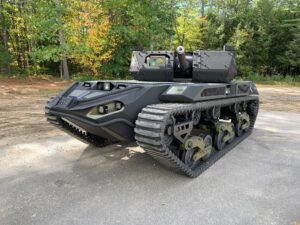Textron [TXT and its team of Howe & Howe and FLIR [FLIR] is set to deliver the first Ripsaw M5 robotic vehicles for the Army’s Robotic Combat Vehicle-Medium (RCV-M) prototype program before the end of the year, as well as recently receiving an additional deal to deliver an all-electric variant.
Officials told reporters on Thursday the companies have been driving the purpose-built Ripsaw M5 almost daily in preparation for initial deliveries, gathering hundreds of test hours on the platform.

“We’ve been able to take that exact same vehicle, as it sat in the show, and have been able to test it almost daily over the last year. We’ve really dedicated our time and [are] focusing our efforts into making sure that the U.S. Army’s going to get a highly capable, very rugged and very reliable vehicle,” said Michael Howe, president of Howe & Howe Technologies. “We’re on schedule for the contract. Things are being produced daily here. We have multiple chassis on the floor being developed at the same time, so we’re able to not only test these vehicles…but to keep developing the actual vehicles themselves for the contract.”
In January, the Army announced it selected the Textron team for the RCV-M test effort, which covers delivery of four prototype vehicles to be used in experiments that will inform final requirements for the future program of record (Defense Daily, Jan. 9).
“We’ll be continuing to work closely with the Army in support of driving their vision forward for the RCV-M program. We’ve made significant progress over the last few months putting 300 miles on the vehicle as we move through our system integration and test activities. Deliveries of our Ripsaw M5 are on track for the coming months,” Sara Willett, Textron’s program director for ground robotics, told reporters.
Willett said the recent award for an all-electric variant of Ripsaw 5 is intended to support the Army’s next Project Convergence event, which is a demonstration to see how the service’s future weapon systems could form a new “sensor-to-shooter” network, with that vehicle delivery to take place in 2021.
Howe noted the standard Ripsaw M5 is nearly all-electric as well, except for a diesel-powered range extender.
“It has the same exact electric performance. All these Ripsaws are all-electric. The difference with the M5 is that it has a diesel range extender. This range extender is just a generator, and it allows the vehicle to go from a smaller range to an extended range out to 300, 400 miles,” Howe said, also noting the robotic vehicle’s robust horsepower level. “The Ripsaw, weighing one-tenth of the M1 [Abrams tank], has 300 more horsepower than the [Abrams].”
Over the summer, the Army held its first robotic vehicle experiment with surrogate platforms and demonstrated successful software and connectivity capabilities that will inform final requirements (Defense Daily, Aug. 6).
The Phase 2 experiment, set to take place in FY ‘22, will be the first demonstration with the Ripsaw M5 as the RCV-M prototype and will put the vehicle through a company-level demonstration.